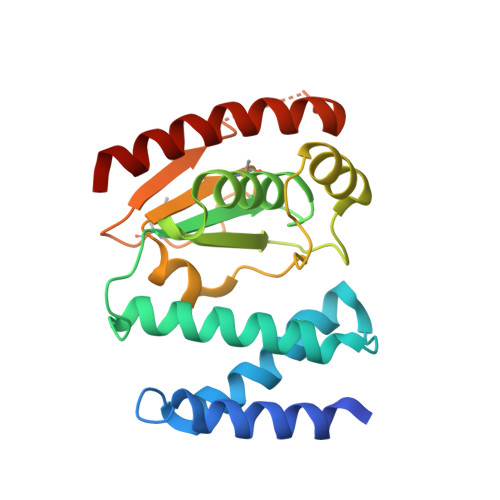Corynebacterium glutamicum survives arsenic stress with arsenate reductases coupled to two distinct redox mechanisms.
Villadangos, A.F., Van Belle, K., Wahni, K., Tamu Dufe, V., Freitas, S., Nur, H., De Galan, S., Gil, J.A., Collet, J.F., Mateos, L.M., Messens, J.(2011) Mol Microbiol 82: 998-1014
- PubMed: 22032722
- DOI: https://doi.org/10.1111/j.1365-2958.2011.07882.x
- Primary Citation of Related Structures:
3RH0, 3T38 - PubMed Abstract:
Arsenate reductases (ArsCs) evolved independently as a defence mechanism against toxic arsenate. In the genome of Corynebacterium glutamicum, there are two arsenic resistance operons (ars1 and ars2) and four potential genes coding for arsenate reductases (Cg_ArsC1, Cg_ArsC2, Cg_ArsC1' and Cg_ArsC4). Using knockout mutants, in vitro reconstitution of redox pathways, arsenic measurements and enzyme kinetics, we show that a single organism has two different classes of arsenate reductases. Cg_ArsC1 and Cg_ArsC2 are single-cysteine monomeric enzymes coupled to the mycothiol/mycoredoxin redox pathway using a mycothiol transferase mechanism. In contrast, Cg_ArsC1' is a three-cysteine containing homodimer that uses a reduction mechanism linked to the thioredoxin pathway with a k(cat)/K(M) value which is 10(3) times higher than the one of Cg_ArsC1 or Cg_ArsC2. Cg_ArsC1' is constitutively expressed at low levels using its own promoter site. It reduces arsenate to arsenite that can then induce the expression of Cg_ArsC1 and Cg_ArsC2. We also solved the X-ray structures of Cg_ArsC1' and Cg_ArsC2. Both enzymes have a typical low-molecular-weight protein tyrosine phosphatases-I fold with a conserved oxyanion binding site. Moreover, Cg_ArsC1' is unique in bearing an N-terminal three-helical bundle that interacts with the active site of the other chain in the dimeric interface.
Organizational Affiliation:
Department of Molecular Biology, Area of Microbiology, University of León, León, Spain.
















